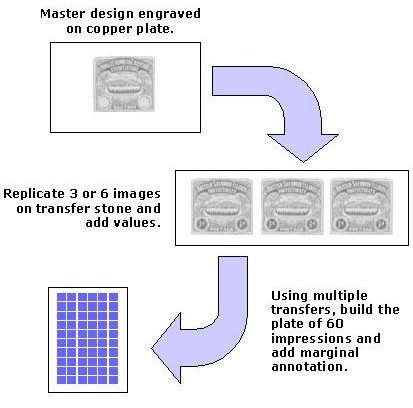 |
Production of the Large Canoe Issue |  |
The Large Canoe issue was produced by lithography, which almost always yields stamp-to-stamp differences. Couple this with work being done by a printer with no philatelic experience, and the result is a most interesting set of stamps! |
 |
According to Gisburn, W.E. Smith and Co., the selected printer, prepared a master design on a copper plate "about the size of a lady's visiting card." This engraving was used to produce transfer stones of either three impressions (½d, 2½d) or six impressions (1d, 2d, 5d, 6d, 1/-). The actual values of the particular stamps were then added to the transfer stones. The transfer stones were used in turn to produce the actual plates of sixty images that were used in the printing. (For a detailed description of the lithographic production process, see Williams.) The left-hand margin of the plate includes an inscription reading from bottom to top stating, "Sixty Stamps at . . ." followed by the value of the stamp spelled out, e.g. "One Halfpenny". Following printing, the sheets were numbered consecutively in the upper right corner. Additionally, there is a "roughly-inscribed cross" in the center of the top margins of the 2d and 6d. |
 |
The paper used was a thick white wove without a watermark. The gum selected by the printers is a quite distinctive glossy white. Unfortunately, it was not appropriate for stamps to be stored and used in the tropics, and many sheets became so stuck together that they had to be destroyed before sale. Gisburn is emphatic that only one printing of the stamps was done and that variations in color are due to the amount of ink applied to the plates, plate wear, and climatic action. Shades ranging from deep to pale can be found for all the stamps. However, in the cases of the ½d and 6d, many would disagree with Gisburn. There appear to be two distinct shades for these stamps. In fact, Bridger and Kay lists distinct color varieties for these two values. In the case of the 6d the color differences appear to be more than mere shade variations. To most observers, the two colors appear to be red brown and chocolate. How this might have happened in a single printing is anyone's guess, but it is certainly possible that the printer ran out of one ink and had to switch in the middle of the process. The printer supplied 60,000 each of the ½d, 1d, 2d, and 2½d values and 30,000 each of the 5d, 6d, and 1/- values. The stamps first went on sale February 14, 1907, and were withdrawn on November 1, 1908. Woodford was quite meticulous in keeping records of the disposition of the stamps, so we know that with destruction of the stuck-together sheets, the following quantities were actually issued: |
½d |
45,364 |
2½d |
12,072 |
|
1d |
25,598 |
5d |
8,310 |
|
2d |
20,641 |
6d |
7,853 |
|
1/- |
7,281 |

horizontal strip of six ½d stamps |

horizontal strip of six 1d stamps |

horizontal strip of six 2d stamps |

horizontal strip of six 2½d stamps |

horizontal strip of six 5d stamps |

horizontal strip of six 6d stamps |

horizontal strip of six 1sh stamps (all "Aore" coll.) |